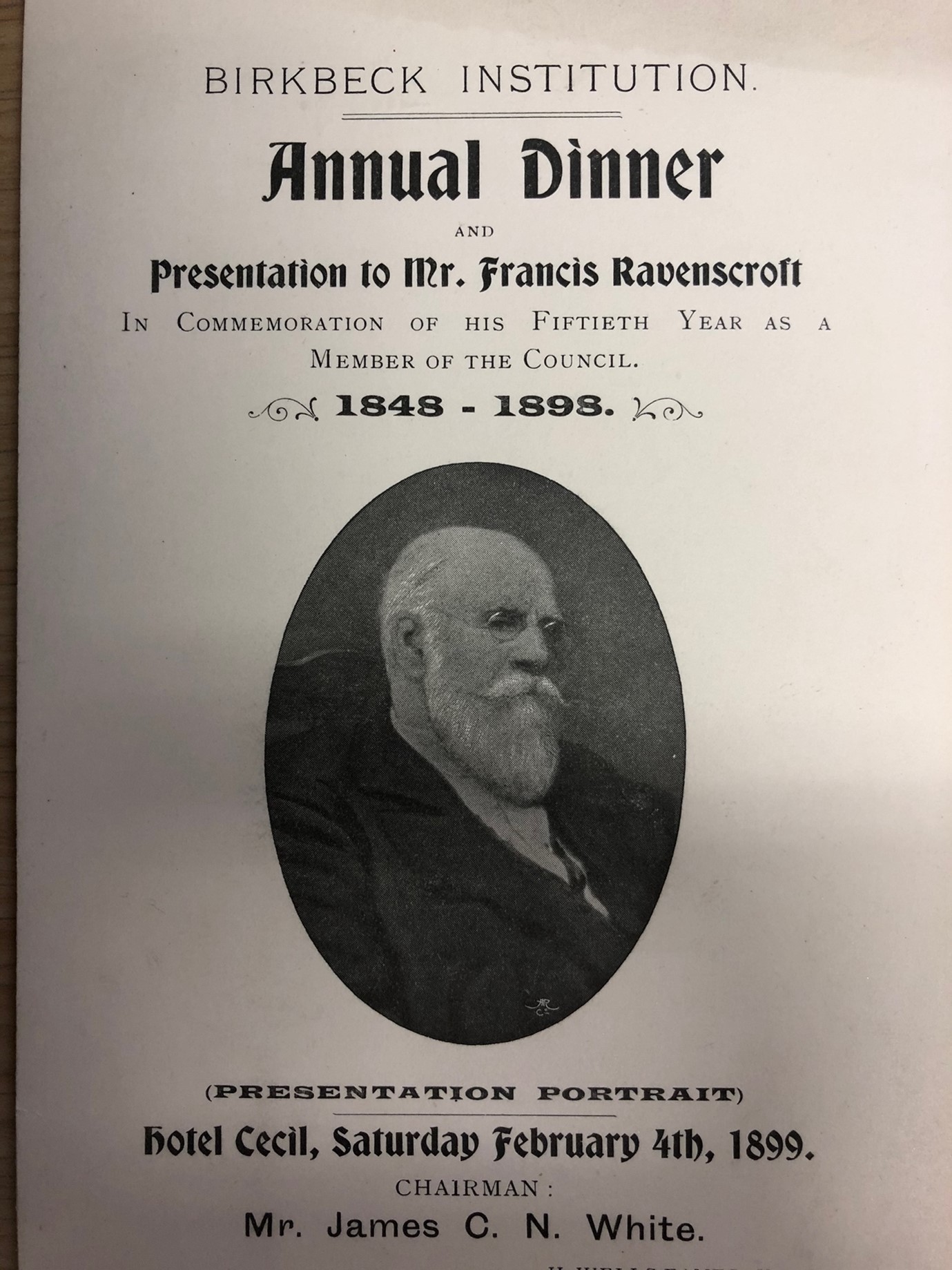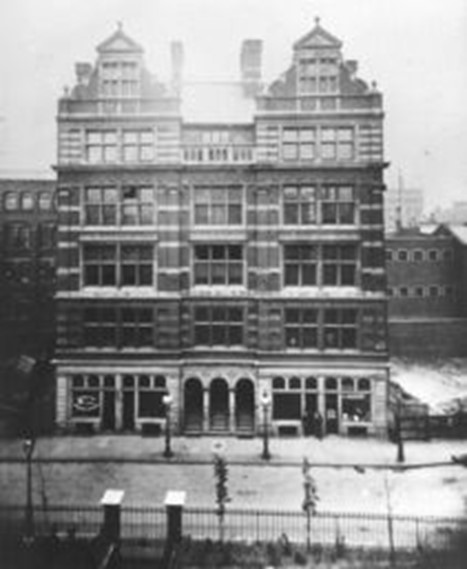By Joanna Bourke, Professor Emerita of History, Birkbeck and author of Birkbeck: 200 Years of Radical Learning for Working People (OUP, 2023)
The London Mechanics Institution (LMI, now known as Birkbeck, University of London) had many founders. Five deserve special mention. Obviously, there is George Birkbeck, physician and philanthropist, who lent his name and status to the fledging college and led it from 1823 to 1841. There are also Joseph Clinton Robertson and Thomas Hodgskin who, as editors of the Mechanics’ Magazine, sent out the initial invitation, inviting people interested in workers’ education to meet at the Crown and Anchor Tavern. Radical politician Francis Place and political and legal titan, Henry Brougham, are the other two founders of the college.
But one man is often forgotten: Francis Ravenscroft. Technically, he was not a founder. Indeed, when he joined the LMI as an ambitious nineteen-year-old in June 1848, the Institution was already in its twenty-fifth year of existence. However, the LMI was definitely in terminal decline. Founder and president George Birkbeck had died seven years earlier and his son, William Lloyd Birkbeck, had inherited the Presidency. William Birkbeck had different interests to his father. He was frequently absent from governance meetings. The LMI was also a victim of its success. It had convinced the elites of Britain of the importance of education, meaning that numerous other educational organisations and libraries had been established. The LMI found itself competing with thorsands of other ‘literary and scientific’ institutions, as well as government-funded schools. In the early 1850s, there were more than 1,500 evening schools for adults in England and Wales, catering for nearly 40,000 pupils. In London alone, there were 28 different Mechanics Institutes. Student numbers at the LMI had plummeted; it was unviable. As one long-standing member of the LMI’s managing committee later recalled, ‘public enthusiasm’ for the LMI was dying. The Institution was ‘hopelessly in debt, was badly housed, and dirty, and apparently at its last gasp’.
Ravenscroft was responsible for reversing its fortunes. He enjoyed a meteoric rise within the LMI, impressing the governing committee with his exceptional business and financial acumen. Within a few months of signing up to take classes, Ravenscroft had been elected to the LMI’s management committee; a month later, he was its Chair. As Ravenscroft later admitted at a public meeting, when he was first nominated to become a member of the committee, candidates were required to ‘make a solemn declaration’ that they were at least 21 years old. He wasn’t. ‘At that time I was in the eyes of the law an infant – (laughter) – and consequently was not entitled to serve’, he admitted. However, ‘being ambitious I recklessly signed the printed form – (laughter and ‘Oh, Oh’) – and I am pleased to find that the institution has suffered no harm’.
As a young man, Ravenscroft was not an obvious educationalist. He had been raised in a distinguished wig-making family and was expected to follow his father into that business. Ravenscroft was restless, however, and, at the age of fifteen, became apprenticed to a tea taster. After only four months, he quit. This was a serious matter since breaking a five-year apprenticeship could have seen him thrown into Bridewell prison. Fortunately, his parents convinced the master to cancel the indenture.
Ravenscroft then pursued a career in law, being appointed to work for a barrister and then a solicitor for seven years. The solicitor asked him to deal with a case involving ‘a building society in difficulties’ due to ‘the misconduct of the manager and the society being unable to meet its liabilities’. This gave Ravenscroft the opportunity ‘of thoroughly investigating and properly understanding the general routine and intricacies of building societies’. He concluded that, if ‘properly and honestly managed, with resources to meet withdrawals’, building societies could be a ‘safe and profitable investment’. Ravenscroft’s problem was ‘providing a fund wherewithal to pay withdrawals upon demand’. This gave him the idea of also opening a deposit bank linked to the building society, promising that at least three-quarters of the money would be invested in Consols (that is, government bonds), or other ‘convertible securities’. Ravenscroft drew up a set of rules and a prospectus for his ‘proposed new society’, which he then christened the ‘Birkbeck Bank’, due to his admiration of George Birkbeck. At around this time, his father died, which meant that he came into a large inheritance.
Ravenscroft was already taking classes and serving on the managing committee of the LMI by this stage. He believed that his two interests (banking and education) would benefit by being linked. He appointed Directors of the Birkbeck Building Society from his contacts in the LMI. He made the LMI’s President (William Lloyd Birkbeck) the Bank’s President; Andrew Macfarlane, secretary of the LMI, was appointed as Treasurer; William Eward, vice-president of the LMI, was appointed as a Trustee, as was John Rüntz, who ran the Birkbeck School. Ravenscroft even ‘borrowed’ rooms in the LMI’s building for his Bank and the two organisations shared costs by publishing their prospectuses in the same booklet.
As the Birkbeck Bank and Permanent Building Society flourished (within only a few years, Ravenscroft was turning over £20 million a year as a private banker), so too did his support of the LMI. In the words of James C. N. White (Chair of the LMI), ‘we went to [Francis Ravenscroft] whenever we required assistance, and we never went in vain’.
The most urgent problem for the LMI was their need for new premises. The Southampton buildings had been inadequate for decades but, when the governing committee of the LMI sought to raise money for a building through public subscriptions, they met with little support. This was where Ravenscroft stepped in, agreeing ‘to play the part of the Good Fairy’. Ravenscroft ‘personally guaranteed the entire cost of the new building; he also undertook, at a later stage, to obtain an advance from his bank on ‘favourable terms’. He threw his energies into collecting subscriptions for the Building Fund and collected just under £4,000 (that is, around half a million pounds today). Subscribers included royalty, William Lloyd Birkbeck, numerous guilds and corporations (including the City of London), and London’s most prominent citizens, including many of Ravenscroft’s friends and family. The building they acquired was Bream’s Building, located near Fleet Street and formerly the home to publishers and printers. The surveyors boasted that ‘Every part of the building is light: there are no dark corners’. In short, it was perfect for the LMI.
In 1866, Ravenscroft was also largely responsible for changing the name of the London Mechanics’ Institution to the Birkbeck Literary and Scientific Institution, commonly known as ‘The Birkbeck’. He could often be seen strolling around ‘The Birkbeck’ in a beautifully-tailored suit of ‘deep blue-black broad-cloth… with a waistcoat cut in a clerical manner, with a row of little buttons on one side, and black velvet skull cap’. Although the relationship between the LMI/Birkbeck had always been a mutual one, Ravenscroft was tireless in his praise of the college. ‘My gratitude’, he maintained, knows no bounds, for it is very largely [due] to my association with the Birkbeck that I owe my success in life. This obligation I can never forget, and the sense of it increases as the years go by. Any efforts of mine, therefore, to promote the interests of the institution I regard as but a poor and inadequate return for the benefits that I have myself received. It was a generous remark from a brilliant and benevolent man.
Ravenscroft served the LMI from 1849 until his death in 1902, 53 years. In 1893, The Birkbeck Institution Magazine quipped that ‘there is only one thing that Mr. Ravenscroft has ever refused to do for our Institution, that is to make a speech’. When asked to, he would reply ‘I am a man of figures, not of words’.
Today, Ravenscroft is known for the company ‘Ede and Ravenscroft’, the famous wig and gown makers, founded in 1689, whose robes Birkbeck students still wear on ceremonial occasions such as graduations. But Francis Ravenscroft deserves to be celebrated not only for building one of the greatest banks of the nineteenth century (later taken over by National Westminster) and creating exquisite gowns, but also for being a great educationalist. Birkbeck owes its continued successes to him.



